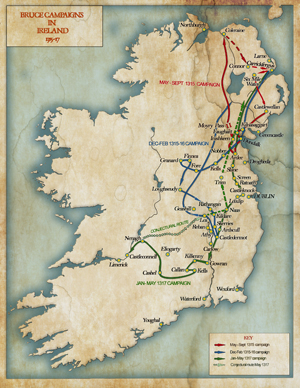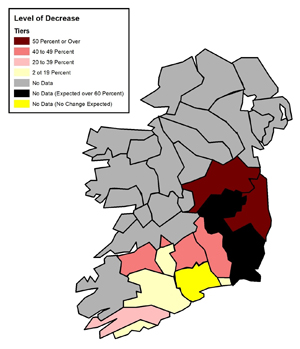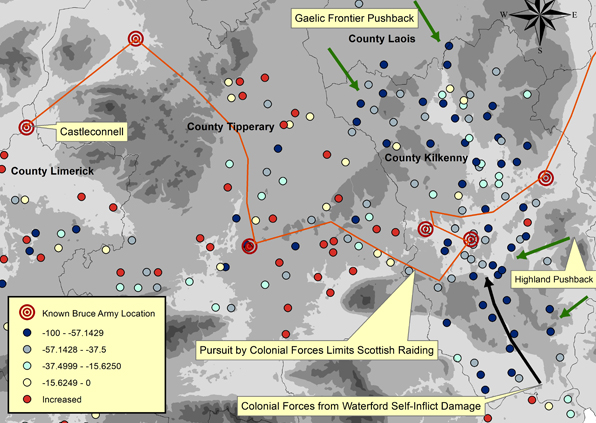Mapping and measuring the impact of the Bruce invasion
Published in Features, Issue 5 (September/October 2019), Volume 27By Chris Chevallier
The Bruce invasion was a major turning point in medieval Irish history, a calamity that seriously damaged English influence in Ireland until the Tudor Reconquest. At the very least, it weighted the scales against the colonial administration. This article will evaluate the impact of these events by analysing percentage changes in valuations for individual parishes and dioceses between the 1302–7 and 1319–20 assessments, something that will flesh out local and regional effects.
Causes?
The causes of the Bruce invasion continue to be discussed and debated. There are four major theories: (i) the Bruces wished to establish a permanent kingdom in Ireland; (ii) the invasion was meant to prevent the transport of supplies and soldiers from Ireland to the Scottish war front; (iii) Robert Bruce wished to remove his brother (Edward) as an heir to and potential rival for his crown; (iv) the invasion would catalyse a ‘Celtic’ alliance between the Irish, Scots and Welsh.
Considering the resources that Robert invested in the invasion and the vulnerable situation in which it placed Scotland, the establishment of a kingdom for Edward was most likely the prime motivator. Holding Ulster, at least, would greatly secure Scotland’s borders and create a launching point for expeditions into Wales, as well as helping to control the Irish Sea. Robert and Edward were also descendants of Norman aristocrats—a drive for adventure and conquest was ingrained in their culture. Ireland provided an opportunity for new expeditions and lands. Appealing to a shared Gaelic or Celtic identity was more likely a means to an end, whereas hurting the English war effort could have been a secondary motive. It is also important to note that Domhnall mac Briain Ó Néill offered a certain legitimacy to Edward’s ambitions, trading his claim to the high-kingship of Ireland and his fealty in exchange for aid against encroaching Gaelic and Anglo-Norman lords.
Chaos and calamity
In late May 1315 Edward Bruce landed near Larne with an army of Scottish veterans. After defeating the local Anglo-Norman magnates in the earldom of Ulster, Edward would establish a court at Carrickfergus and receive the fealty of Ó Néill and several other Gaelic Ulster lords. He would also force the submission or entice the defection of some Anglo-Norman lords in Ulster and, eventually, parts of Meath. From eastern and central Ulster, the Scottish army and their Gaelic allies were able to raid southwards from a somewhat secure base.
In 1315–16 Edward’s offensive activity was largely confined to Louth, the midlands and Kildare. In September 1315 he defeated the Red Earl of Ulster (Richard de Burgh) at the Battle of Connor (Co. Antrim). The earl, who was also lord of Connacht, denied the colonial administration’s army permission to enter Ulster, fearing that it would devastate his lands. Rather, he trusted in his own forces to oust the Scots. This backfired spectacularly, as Edward’s diplomacy with the Ó Conchobair caused chaos and civil war in Connacht, leading to both Anglo-Norman and Gaelic contingents of the earl’s army from Connacht rushing west to secure their homes and power. Thus the Scots were able to smash de Burgh’s greatly reduced army.
After the Battle of Connor, the Scots and their allies would win victories at Kells (Co. Meath) and Ardscull (Co. Kildare) as well, thereby gaining an aura of invincibility. During these initial years Edward further secured his position in Ulster, making tangible efforts to rule it as a proper king. Carrickfergus Castle would fall in 1316 after a year-long siege. This, combined with the successes of Scottish admiral Thomas Dun in hampering England’s navy, made the possibility of Bruce’s kingdom seem like an imminent reality. The presence of the Scots and their propaganda also helped to cause chaos across Ireland. There are records of settlers fleeing their homes in south-west Munster, while Gaelic rebels were even able to raid Dublin city. The Scots presented an opportunity to tip the political equilibrium in Ireland against the colony and to dislodge settlements. Some lords, however, were more successful than others.
In August 1316 Fedlim Ó Conchobair led a massive Gaelic army against William Liath de Burgh and his Gaelic allies, with the intention of eliminating his rival for supremacy over Connacht. This culminated in the Second Battle of Athenry. Fedlim and countless Gaelic nobles died during the battle, resulting in an astounding de Burgh victory. This family would assert control over much of the region for the remainder of the medieval period, largely integrating into Gaelic society and culture while breaking away from the colonial administration.
In Thomond, however, it was Gaelic forces that prevailed against an ambitious Anglo-Norman lord. At the Battle of Dysert O’Dea in 1318 a Gaelic army outsmarted and devastated a colonial army under Richard de Clare, killing him, many nobles and much of his army. De Clare’s wife (Joan) and her retinue would quickly grab their treasures and torch the colonial stronghold at Bunratty. The colonial presence would linger in Thomond until the early 1330s, but they could not stop the Ó Briain from re-establishing control over the region.
Robert joins his brother
The year 1317 would prove to be a pivotal one for the colony. Robert joined his brother Edward in February, launching a campaign into the colony’s heartland and towards Dublin. The citizens of Dublin, angered by a lack of leadership and direction, took matters into their own hands. Ripping down homes and churches, the populace joined together to build a wall facing the River Liffey. They also set fire to Dublin’s suburbs to prevent the Scottish army from using them during a siege. The fire spread farther than expected, however, and devastated the area. Not having foreseen such resistance and deterred by the prospect of a prolonged siege, the Bruces disengaged.
 They struck instead at Leixlip, Naas, Castledermot, Gowran and Callan. A colonial army under Edmund Butler mustered near Kilkenny, however, leading the Bruces to divert westwards in the hope of joining forces with the Ó Briain. Cutting across Tipperary, they got as far as Castleconnel, but the ruling branch of the Ó Briain that faced them was not the one with which they had negotiated (rather, it was a rival branch). With news of Roger Mortimer’s landing at Youghal with fresh forces and an army of crossbowmen from Genova en route, the Bruces decided to retreat towards Ulster. Edward marched southwards one last time in October 1318, only to be defeated in the Battle of Faughart (14 October 1318). His reputation shattered, he was confronted by John de Bermingham and Edmund Butler. Not far from where he was crowned high-king, he was slain as his army was decisively routed. Thus ended the Bruce invasion of Ireland.
They struck instead at Leixlip, Naas, Castledermot, Gowran and Callan. A colonial army under Edmund Butler mustered near Kilkenny, however, leading the Bruces to divert westwards in the hope of joining forces with the Ó Briain. Cutting across Tipperary, they got as far as Castleconnel, but the ruling branch of the Ó Briain that faced them was not the one with which they had negotiated (rather, it was a rival branch). With news of Roger Mortimer’s landing at Youghal with fresh forces and an army of crossbowmen from Genova en route, the Bruces decided to retreat towards Ulster. Edward marched southwards one last time in October 1318, only to be defeated in the Battle of Faughart (14 October 1318). His reputation shattered, he was confronted by John de Bermingham and Edmund Butler. Not far from where he was crowned high-king, he was slain as his army was decisively routed. Thus ended the Bruce invasion of Ireland.
This conflict played out against the backdrop of the Great European Famine. As the fourteenth century began, the optimal climate that had defined the high medieval period was sliding towards the Little Ice Age, bringing harsh winters, variable agricultural seasons and violent weather. Not only was this a drain on human and animal health, something which increased susceptibility to disease, but it also created prime conditions for famine. Severe storms and rainfalls destroyed crops, while harsh winters limited the grazing options for cattle, meaning that fodder was required to sustain herds. While the population starved, the conditions also limited the supplies available for armies. This explains the Scots’ reluctance to conduct sieges, as well as helping to clarify how Edward Bruce earned the enmity of both Gaelic and colonial Ireland. Scottish pillaging and destruction only increased hardship for all parties exponentially. Hence Edward’s death was met with joy, as attested to in the Annals of Connacht.
 Methods
Methods
Comparison of the ante-bellum and post-bellum Irish valuations is not a straightforward task. Dioceses can have vastly different orderings of parishes, parishes can have disparate spellings, diocesan totals were not always calculated by the scribes, and some areas were too devastated to be revalued. The situation is not helped by the fact that some parishes gained wealth between the pre-war and post-war valuations, creating confusion over the dating of the contents. This necessitated a manual recounting of the diocesan values to ascertain their totals, helping to properly date the valuations and gauge regional changes. Once this was completed, the ante-bellum values for parishes were matched with their post-bellum counterparts, allowing for percentage change to be calculated per parish church. The parishes in the revalued dioceses were organised into deaneries, helping to streamline this process.
Results
It’s not simply the comparison of the ante-bellum and post-bellum values that offers interesting insights but also the nature of the data themselves. It is vitally important to note that only colonial dioceses were revalued. While it is possible that some 1319–20 records were misplaced or damaged, I suggest that lands outside of these dioceses were too chaotic, devastated or independent to be revalued. It is no coincidence that the revalued areas largely coincide with territory that would remain under England’s influence during the late medieval period. Essentially, these areas form the cores and bastions of the colonial administration and allied Anglo-Norman lords.
Parishes generally were not devalued by clean fractions (such as a quarter or a half) and neighbouring parishes often had different percentage changes. This, combined with the fact that some parishes became wealthier, strongly suggests that proper and extensive revaluations were conducted. The only exception to this is Meath, which was given a uniform devaluation of 50%. Another important outlier to note is Dublin. Of the revalued dioceses, Dublin stands out for the number of parishes that were too wasted by conflict to be revalued, and some deaneries were not even mentioned at all. These excluded deaneries bordered mountainous territory prone to Gaelic raiding. Because of these limitations, these two dioceses were not included in the parish change map.
Table 1—Decrease in total diocesan wealth.
| Diocese | Percentage decrease |
| Dublin | 58 |
| Meath | c. 50 |
| Ossory | 44 |
| Waterford | 2 |
| Cashel | 49 |
| Emly | 14 |
| Cork | 29 |
| Ross | 16 |
| Cloyne | 18 |
| Limerick | 40 |
Table 1 shows the changes in diocesan totals, comparing the pre-war and post-war valuations. The comparative results mesh with the events of the invasion. The highest destruction corresponds with areas through which the Scottish army raided and marched, namely Leinster and north Munster. Dublin, Meath, Ossory, Cashel and Limerick felt the biggest impact. Waterford and south Munster, however, were relatively unaffected. Based on their position and the context of the invasion, I contend that Kildare, Leighlin and Ferns dioceses faced devaluations of over 60%, preventing a proper revaluation from being carried out. This contiguous region was in a vice between independent Gaelic lordships to the west in the midlands and the coastal mountains to the east. Kildare also faced Scottish forces multiple times. Conversely, Lismore is absent because it saw little to no change. Most of the diocese’s neighbours faced comparatively low devaluations. Additionally, the diocese was partly insulated by its terrain, as well as benefiting from access to the ports and commerce of Waterford, Youghal, Cork and Dungarvan.
The level of destruction in Dublin, however, is jarring. Not only was there a Scottish presence but also Gaelic raiding, self-destruction to deter a Scottish siege of the city and the mustering of colonial armies all took their toll. Even friendly armies could cause destruction and often pillaged supplies to sustain themselves. Documents show that colonial armies were castigated for the destruction they wrought, even being cast in a similar light to the Scottish army.

The data allow the advance of the Scottish army (orange) to be tracked with greater precision, and the devastation caused by foraging colonial armies, Gaelic forces and rebels to be better understood.
Moving away from larger regional trends to parish data also provides further interesting insights. The average parish change per diocese is presented in Table 2. The first column (of percentages) represents overall diocesan change; the second represents diocesan change while excluding any parishes that increased in wealth in order to better illustrate the damage done to affected parishes. What can explain these intriguing dramatic increases in parish wealth in some dioceses? It is possible that between valuations these parishes had recovered from conflicts c. 1302–7 and had been spared the worst effects of the invasion, and therefore the recovery outstripped the damage. It is also important to note that when Robert and Edward ventured west they were pursued and harried. This limited their ability to pillage and forage in the countryside and so they may have focused on specific wealthy targets during their march.
Table 2—Overall changes in parish values.
| Diocese | Overall average parish change | Average parish change (decreases only) |
| Dublin | –68 | N/A |
| Meath | –c. 50 | N/A |
| Ossory | –47 | –53 |
| Waterford | –20 | –26 |
| Emly | –24 | N/A |
| Limerick | +23 | –44 |
| Cashel | +28 | –10 |
| Cloyne | –1 | –16 |
| Ross | –10 | –27 |
| Cork | –30 | –34 |
Where parish changes were most drastic also offers several insights. In County Cork parish changes were more dramatic where there was a border with Gaelic lordships. Parishes on the border of Lismore and deeper in colonial territory, however, were relatively unaffected. Gaelic parishes in West Cork and the Beara Peninsula, which were further inside Gaelic domains, are in the lowest tier of devaluation. We see a similar phenomenon at the border of Leinster and Munster. Along the mountain ranges that served as refuges for Gaelic lords and outlaws of all cultures the devastation appears to have been particularly high. Colonial domains insulated from these conflict zones (just north of Lismore) and away from Bruce’s movements, however, are where parish increases largely occur.
Conclusions
After the invasion Roger Mortimer was able to stabilise some of the colony’s frontier. There are records of economic recovery, as well as attempts to found a university in Dublin. Indeed, the papal taxation sources illustrate that the colonial economy was resilient and able to recover from war. Nevertheless, the Bruce invasion helped set events in motion that would turn the tide against the colony. Colonial control in Thomond would collapse, the de Burghs of Connacht would break ties with the colonial parliament and the earldom of Ulster would collapse through civil war. The most important casualty was the prestige of the Dublin administration. The Bruce invasion catalysed localisation, Gaelicisation and accommodation of Gaelic tribes, as colonial magnates sought new ways to expand and secure their power in the light of an administration that could not fully protect or rule them.
The 1302–20 ecclesiastical valuations offer a fascinating and unique look into medieval Ireland, providing insights into the economy, the extent and nature of colonisation, the political landscape and the devastation left by catastrophes.
Chris Chevallier was recently awarded a Ph.D from Trinity College, Dublin, for his work on ‘Utilizing papal taxation records for geographical, economic, and cultural analysis: a study of early fourteenth-century Ireland’.
FURTHER READING
S. Duffy, Robert the Bruce’s Irish wars: the invasions of Ireland 1306–1329 (Stroud, 2002).
R. Frame, ‘The Bruces in Ireland, 1315–18’, Irish Historical Studies 19 (73) (1974).
J. Lydon, ‘Impact of the Bruce Invasion’, in A. Cosgrove (ed.), New History of Ireland, vol. II (Oxford, 2008).
C. McNamee, The wars of the Bruces (New York, 2012).
















